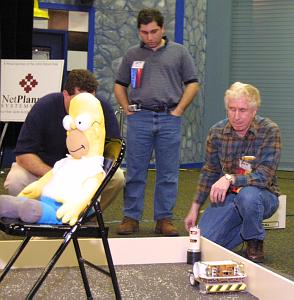 |
|
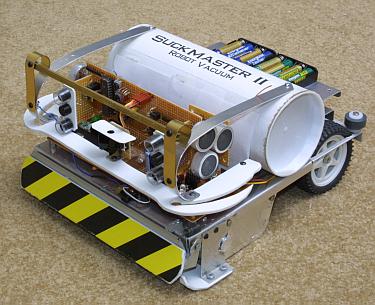
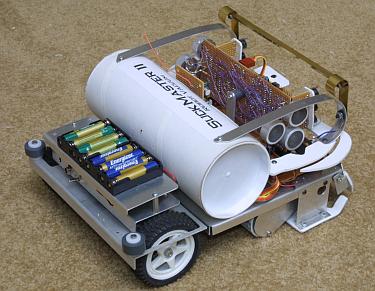
|
Suckmaster II Robot Vacuum by Dale Heatherington Feburary 2002 |
|---|---|
|
This robot was designed to compete in the annual AHRC Robot Rally
Vacuum contest. The contest goal is to pick up as much rice as possible
in 4 minutes or less from an 8 foot square simulated room. The simulated room
is sprinkled with 8 ounces of rice and contains a folding chair, lamp and speaker box.
Bonus points are scored if the robot returns to the starting location and turns itself off.
During the 2002 contest the robot picked up 6.14 ounces of rice in 3 minutes 32 seconds and returned to the starting point for a score of 129.93 and first place. If you want to see the schematics and source code click here to download a zip file. This information may be incomplete or contain errors and is not intended to be used to duplicate the Suckmaster II. |
|
|
News |
| May 13 2006: Suckmaster wins AHRC Vacuum Contest 4 years in a row. (There was no Robot Rally in 2005) This year Suckmaster II picked up 6.11 oz. of rice in 3 minutes 52 seconds for score of 127.9. The 2nd place Vac-O-Matic managed a respectable score of 52.76. This was the final vacuum contest. It will be replaced with a new contest next year. |
| May 15 2004: Suckmaster wins AHRC Robot Rally Vacuum Contest three years in a row. This year Suckmaster II picked up 6.88 oz. of rice in 3 minutes 30 seconds for a new record score of 150.7! It managed to do this even after being dropped on the floor a careless spectator. |
|
Feb. 15 2003: Suckmaster wins AHRC Robot Rally
Vacuum Contest two years in a row.
This year Suckmaster II picked up 6.11 oz. of rice in 3 minutes 36 seconds for a score of 128.9.
|
| Data Sheet | |
|---|---|
| Size | 9.75in(W) x 10.5in(L) x 5.5in(H) |
| Weight | 3 lbs 6 oz (1.54kg) |
| Main CPU | PIC16F877 8K ROM 368 Byte RAM |
| Sonar CPU | PIC16C73 |
| Programming Language | C and assembler |
| Motors | Two 12v 200 rpm gear motors |
| Motor driver chip | L293D |
| Speed Control | Software generated Pulse Rate Modulaton with Back-EMF feedback. Pulse width is constant. |
| Tires | Two 2.75 inch RC car tires |
| Top Speed | 2 feet/sec |
| Power | 16 AAA NiMH batteries (19.2 volts) |
| Sensors | 4 channel sonar 2 front bump switches Two ground speed sensors IR transmitter and 2 receivers for beacon tracking |
| Pickup device | Foam rubber paint roller spinning at 1200 rpm throws rice into 3 inch diameter cardboard mailing tube. |
| Telemetry | Connector for external transmitter Linx TXM-418-RM (9600 baud 418 MHZ) |
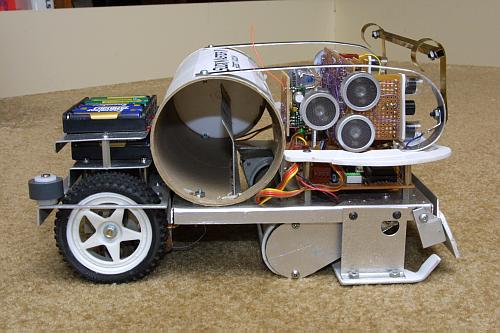
Right Side Shows rice collection tube with end cover removed. Rice is scooped up by the spinning paint roller and thrown upward into the collection tube where it collects behind the metal baffle.
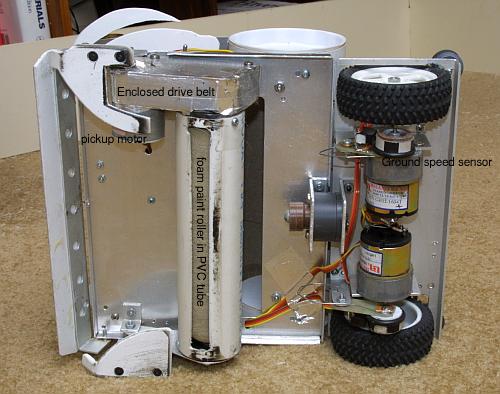
Bottom view.
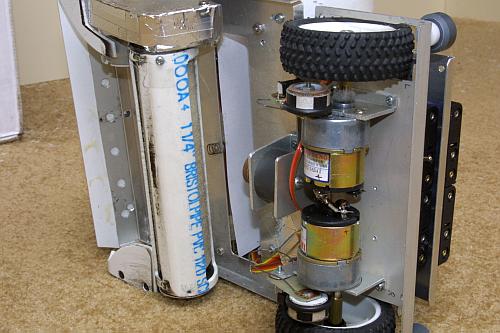
Bottom rear view.
Operation
|
